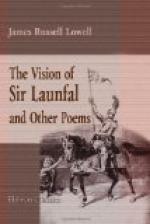About the time of his marriage, he published two books which, by their character, show pretty well the divided interest of his life. His bent from the beginning was more decidedly literary than that of any contemporary American poet. That is to say, the history and art of literature divided his interest with the production of literature, and he carried the unusual gift of a rare critical power, joined to hearty spontaneous creation. It may indeed be guessed that the keenness of judgment and incisiveness of wit which characterize his examination of literature sometimes interfered with his poetic power, and made him liable to question his art when he would rather have expressed it unchecked. One of the two books was a volume of poems; the other was a prose work, Conversations on Some of the Old Poets. He did not keep this book alive; but it is interesting as marking the enthusiasm of a young scholar treading a way then almost wholly neglected in America, and intimating a line of thought and study in which he afterward made most noteworthy venture. Another series of poems followed in 1848, and in the same year The Vision of Sir Launfal. Perhaps it was in reaction from the marked sentiment of his poetry that he issued now a jeu d’esprit, A Fable for Critics, in which he hit off, with a rough and ready wit, the characteristics of the writers of the day, not forgetting himself in these lines:
There is Lowell, who’s
striving Parnassus to climb
With a whole bale of isms
tied together with rhyme;
He might get on alone, spite
of brambles and boulders,
But he can’t with that
bundle he has on his shoulders;
The top of the hill he will
ne’er come nigh reaching
Till he learns the distinction
’twixt singing and preaching;
His lyre has some chords that
would ring pretty well,
But he’d rather by half
make a drum of the shell,
And rattle away till he’s
old as Methusalem,
At the head of a march to
the last new Jerusalem.




